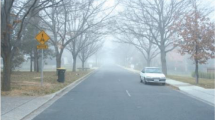Abstract
Poor visibility due to the effects of light absorption and scattering is challenging for processing images captured in foggy weather conditions. This paper proposes an effective algorithm for single image fog removal based on degradation model and group-based sparse representation (GSR). The proposed degradation model is constructed based on a classical physical model, i.e., dichromatic atmospheric scattering model. Then, the new degradation model is integrated into the group-based sparse representation framework. Finally, the single image defogging problem is regarded as an image restoration problem, which can be well optimized by GSR. The method is compared with several well-known algorithms from the literature using qualitative and quantitative evaluations, and results indicate considerable improvement over existing algorithms.








Similar content being viewed by others
References
Xie CH, Qiao WW, Liu Z (2016) Single image dehazing using kernel regression model and dark channel prior. SIViP 11:1–8
Tripathi AK, Mukhopadhyay S (2014) Efficient fog removal from video. SIViP 8(8):1431–1439
Kim TK, Paik JK, Kang BS (1998) Contrast enhancement system using spatially adaptive histogram equalization with temporal filtering. IEEE Trans Consum Electron 44(1):82–87
Al-Sammaraie MF (2015) Contrast enhancement of roads images with foggy scenes based on histogram equalization. In: Proc. the 10th int. conf. comput. sci. educ., pp 95–101
Zhou J, Zhou F (2013) Single image dehazing motivated by retinex theory. In: Proc. the 2nd int. symposium. instrum. meas. sens. net. automat, pp 243–247
Mei X, Yang J, Zhang Y, Li W, Zhang J (2016) Video image dehazing algorithm based on multi-scale retinex with color restoration. In: Proc. the int. conf.. smart grid elec. automat., pp 195–200
Grewe LL, Brooks RR (1998) Atmospheric attenuation reduction through multisensor fusion. Proc SPIE 3376:102–109
Tarel JP, Hautière N (2009) Fast visibility restoration from a single color or gray level image. In: Proc. IEEE int. conf. comput. vision, pp 2201–2208
Tarel JP, Hautière N, Cord A, Gruyer D (2010) Improved visibility of road scene images under heterogeneous fog. In Proc. IEEE intell. veh. symposium, 23(3):478–485
Oakley JP, Satherley BL (1998) Improving image quality in poor visibility conditions using a physical model for contrast degradation. IEEE Trans Image Process 7(2), pp 167–179
Narasimhan SG, Nayar SK (2003) Interactive (de)weathering of an image using physical models. In: Proc. ICCV workshop color photometric methods in comput. vis., pp 1–8
Wang X, Tang Z (2008) Automatic image de-weathering using physical model and maximum entropy. In: Proc. IEEE Conf. Cybernetics Intell. Syst., pp 996–1001
He K, Sun J, Tang X (2011) Single image haze removal using dark channel prior. IEEE Trans Pattern Anal Mach Intell 33(12):2341–2353
Lai Y, Chen Y, Chiou C, Hsu C (2015) Single-image dehazing via optimal transmission map under scene priors. IEEE Trans Circ Syst Video Technol 25(1):1–14
Elad M, Aharon M (2006) Image denosing via sparse and redundant representations over learned dictionaries. IEEE Trans Image Process 15(12):3736–3745
Dong W, Zhang L, Shi G, Wu X (2011) Image deblurring and superresolution by adaptive sparse domain selection and adaptive regularization. IEEE Trans Image Process 20(7):1838–1857
Yang J, Wright J, Huang T, Ma Y (2010) Image super-resolution via sparse representation. IEEE Trans Image Process 19(11):2861–2873
Zhang J, Zhao D, Gao W (2014) Group-based sparse representation for image restoration. IEEE Trans Image Process 23(8):3336–3351
Banham MR, Katsaggelos AK (1997) Digital image restoration. IEEE Signal Process Mag 14:24–41
Nayar SK, Narasimhan SG (1999) Vision in bad weather. In: Proc. IEEE int. conf. comput. vis., pp 820–827
Li X (2011) Image recovery from hybrid sparse representation: a deterministic annealing approach. IEEE J Sel Top Sign Process 5(5):953–962
Mairal J, Bach F, Ponce J, Sapiro G, Zisserman A (2009) Non-localsparse models for image restoration. In: Proc. IEEE 12th int. conf.comput. vis., pp 2272–2279
Dong W, Zhang L, Shi G, Li X (2013) Nonlocally centralized sparserepresentation for image restoration. IEEE Trans Image Process 22(4):1620–1630
Aharon M, Elad M, Bruckstein A (2006) K-SVD: an algorithm fordesigning overcomplete dictionaries for sparse representation. IEEE Trans Signal Process 54(11):4311–4322
Schechner YY, Averbuch Y (2007) Regularized image recovery in scattering media. IEEE Trans Pattern Anal Mach Intell 29(9):1655–1660
Zhang L, Zhang L, Mou X, Zhang D (2011) FSIM: a feature similarity index for image quality assessment. IEEE Trans Image Process 20(8):2378–2386
Wang J, He N, Zhang L, Lu K (2015) Single image dehazing with a physical model and dark channel prior. Neurocomput. 149:718–728
Tripathi AK, Mukhopadhyay S (2012) Single image fog removal using anisotropic diffusion. IET Image Process 6(7):966–975
Acknowledgements
This work was supported in part by the Fundamental Research Funds for the Central Universities (Grant No. 2019B15314, 30918014107), in part by the National Natural Science Foundation of China (Grant No. 61603124), in part by the Jiangsu Government Study Scholarship, in part by the Six Talents Peak Project of Jiangsu Province (Grant No. XYDXX-007), and in part by the 333 High-Level Talent Training Program of Jiangsu Province.
Author information
Authors and Affiliations
Corresponding author
Additional information
Publisher’s Note
Springer Nature remains neutral with regard to jurisdictional claims in published maps and institutional affiliations.
Rights and permissions
About this article
Cite this article
Wang, X., Zhang, X., Zhu, H. et al. An Effective Algorithm for Single Image Fog Removal. Mobile Netw Appl 26, 1250–1258 (2021). https://doi.org/10.1007/s11036-019-01340-5
Published:
Issue Date:
DOI: https://doi.org/10.1007/s11036-019-01340-5




